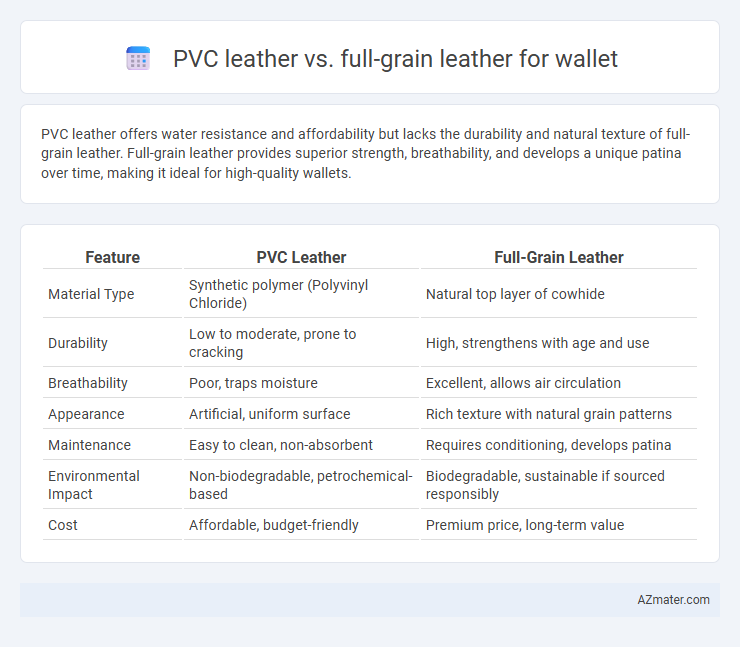PVC leather offers water resistance and affordability but lacks the durability and natural texture of full-grain leather. Full-grain leather provides superior strength, breathability, and develops a unique patina over time, making it ideal for high-quality wallets.
Table of Comparison
| Feature | PVC Leather | Full-Grain Leather |
|---|---|---|
| Material Type | Synthetic polymer (Polyvinyl Chloride) | Natural top layer of cowhide |
| Durability | Low to moderate, prone to cracking | High, strengthens with age and use |
| Breathability | Poor, traps moisture | Excellent, allows air circulation |
| Appearance | Artificial, uniform surface | Rich texture with natural grain patterns |
| Maintenance | Easy to clean, non-absorbent | Requires conditioning, develops patina |
| Environmental Impact | Non-biodegradable, petrochemical-based | Biodegradable, sustainable if sourced responsibly |
| Cost | Affordable, budget-friendly | Premium price, long-term value |
Introduction to PVC Leather and Full-Grain Leather
PVC leather, a synthetic material made from polyvinyl chloride, offers durability and water resistance at a lower cost compared to natural leather. Full-grain leather, sourced from the top layer of animal hide, retains the natural grain and develops a unique patina over time, indicating superior quality and longevity. Both materials serve different market needs, with PVC leather providing an affordable, low-maintenance option while full-grain leather emphasizes premium craftsmanship and natural aesthetics.
Material Composition and Manufacturing Process
PVC leather, made from polyvinyl chloride coated onto a fabric base, undergoes a synthetic manufacturing process involving chemical treatments and plasticizers to achieve durability and flexibility. Full-grain leather, derived from the top layer of animal hide, retains natural grain and undergoes minimal processing such as tanning and finishing to preserve its strength and breathability. The material composition of PVC leather offers water resistance and low maintenance, whereas full-grain leather provides superior aging characteristics, softness, and enhanced durability due to its natural fibers and traditional craftsmanship.
Durability and Longevity Comparison
Full-grain leather offers superior durability and longevity for wallets due to its natural fiber structure and resistance to wear, developing a unique patina over time that enhances its appearance. PVC leather, made from synthetic materials, tends to wear out faster with visible cracking and peeling, lacking the breathability and strength found in genuine leather. Choosing full-grain leather ensures a wallet that withstands daily use and ages gracefully, while PVC leather is more prone to deterioration under similar conditions.
Aesthetic Appeal and Texture Differences
PVC leather exhibits a uniform texture with a glossy finish that mimics genuine leather but often lacks the depth and natural grain found in full-grain leather. Full-grain leather showcases unique, rich textures and subtle imperfections that develop character over time, enhancing the wallet's aesthetic appeal. The tactile experience of full-grain leather is supple and organic, contrasting with the smoother, synthetic feel of PVC leather.
Cost and Affordability Analysis
PVC leather wallets cost significantly less than full-grain leather wallets due to the synthetic manufacturing process and cheaper raw materials. Full-grain leather offers superior durability and ages well but comes with a higher price tag, often making it less affordable for budget-conscious buyers. Consumers prioritizing cost-effectiveness typically prefer PVC leather, while those valuing long-term investment choose full-grain leather despite the increased expense.
Environmental Impact and Sustainability
PVC leather wallets have a significant environmental impact due to their production from non-biodegradable synthetic plastics, releasing toxic chemicals during manufacturing and disposal. Full-grain leather wallets, sourced from the top layer of animal hides, are more sustainable when sourced responsibly, as they biodegrade and can be a byproduct of the meat industry, reducing waste. Choosing full-grain leather with eco-friendly tanning methods further enhances sustainability and reduces chemical pollution compared to PVC alternatives.
Maintenance and Care Requirements
PVC leather wallets require minimal maintenance, needing only occasional wiping with a damp cloth to remove dirt and prevent cracking, making them ideal for those seeking low-effort care. Full-grain leather wallets demand regular conditioning with specialized leather oils or creams to maintain suppleness, prevent drying, and develop a unique patina over time. Avoiding excessive water exposure and storing in cool, dry places further preserves the durability and appearance of full-grain leather, which contrasts with the more resilient and water-resistant nature of PVC leather.
User Experience and Comfort
PVC leather wallets offer affordability and water resistance but often lack breathability, making them less comfortable for extended daily use. Full-grain leather wallets develop a personalized patina over time, enhancing softness, durability, and comfort, which improves user experience through natural material aging. The tactile appeal and flexibility of full-grain leather provide superior comfort compared to the stiffer, synthetic feel of PVC leather.
Common Applications in Wallets
PVC leather is widely used in wallet manufacturing due to its affordability, water resistance, and variety of colors, making it ideal for budget-friendly and fashion-forward designs. Full-grain leather, prized for its durability, natural texture, and aging properties, is commonly chosen for premium wallets that emphasize longevity and a luxurious feel. Both materials cater to different consumer preferences, with PVC appealing to practicality and style diversity, while full-grain leather targets high-end markets valuing craftsmanship.
Which Leather is Better for Wallets?
Full-grain leather offers superior durability, natural texture, and develops a unique patina over time, making it the ideal choice for high-quality wallets. PVC leather, while more affordable and water-resistant, lacks breathability and tends to crack or peel with extended use. For wallets, where longevity and aesthetic aging are valued, full-grain leather outperforms PVC leather in both strength and appearance.

Infographic: PVC leather vs Full-grain leather for Wallet
 azmater.com
azmater.com